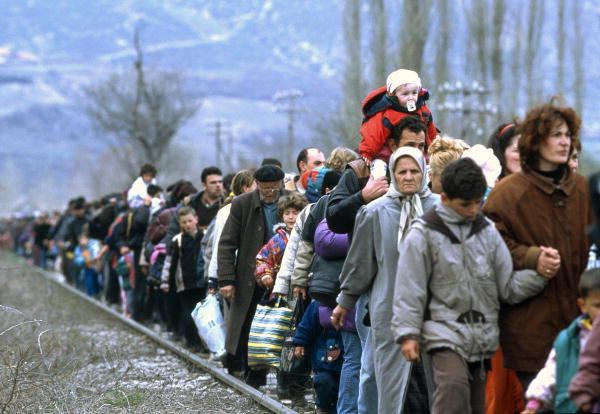Fleeing Persecution and Separation from Family
During those times everyone was afraid, and we taught the children very young to be afraid, so at the age of one or two, they already learned to be afraid and did not cry either.
-Mai Vang Thao, Hmong refugee
All refugees have experiences of loss and/or exposure to traumatic events, either personally or within their communities. Such experiences might include systematic discrimination and intimidation, civil war, ongoing military conflicts, forceful government expulsion from the country, ethnic cleansing, and even genocide. Families living in these contexts often experience violence, or they hear about it in their communities and have reason to fear it. Families’ top priority is to find safety. However, even after they relocate, some families will experience the long-term effects from the traumatic stress they have experienced.

Kosovar refugees fleeing their homeland. [Blace area, The former Yugoslav Republic of Macedonia]
United Nations Photo – Kosovo refugees – CC BY-NC-ND 2.0.
“[The children’s father] was hardly with us. He went off with the men and left us hiding in the jungles. In fact he had prepared that in the event that we could no longer stay, he would leave to Thailand, and the children and I, if captured by the communists, would stay behind since the communist soldiers would not kill us because we are only women and children.”
-Mai Vang Thao, Hmong refugee
The conflicts and situations that cause people to flee their home countries often separate families. Families can become separated in the midst of a conflict or during the process of fleeing or migrating (families can also be separated during the resettlement process, see below). Even if parents and children are kept together through this arduous process, resettlement of an entire family unit (in many cultures, the family unit includes grandparents, aunts and uncles and their families) would rarely occur.
Separation from family members can be a source of guilt, loss, and added pressure. These losses of family ties and community support can often be characterized as ambiguous (Boss, 2006). When a family member dies, the loss is concrete, and the family can mourn. When family members are separated, there can be great ambiguity. Separated loved ones are physically absent but very present in the minds of their family members. Families have difficulty determining who is in the family, and what roles they play. This ambiguity can add to the stress of an already stressful migration. For example, youth separated from their parents during civil war wondered if their families had survived the fighting or had died. They described feelings of loneliness and intense depression. One child described, “The kids were most thinking – Are they alive or are they not alive?” (Luster, Qin, Bates, Johnson, & Rana, 2008, p. 449).
Wondering whether certain family members are alive or dead can cause individuals and families to become stuck with mixed feelings of hope, loss, guilt, and grief. These ambiguous losses compound the concrete losses of homes and family members. The impact of loss and traumatic events can be seen at both the individual and family level. In fact, one study found that the statistical relationships between traumatic events, grief, depression, and PTSD are stronger at the family level than they are at the individual level (Nickerson et al., 2011). Separated individuals must find ways to accept and live with the ambiguity. As one child said of his separation from his parents, “It happened. I did not have any control over it. I just think I wish it did not happen. But it did and I could not do anything about it” (Luster et al., 2008, p. 449).
When refugees are able to remain with close family members, it can ease the strains of relocation and coping with the traumas experienced in the home country. In a study of refugees in Norway, Lie, Lavik, and Laake (2001) found that the presence of close family in Norway had a positive impact on mental health symptoms, especially for those with higher exposure to traumatic events. McMichael, Gifford, and Correa-Velez (2011) similarly found that family connection is particularly important for youth early in the resettlement process.



